Keighley
| Keighley | |
.jpg) A view over Keighley |
|
 Keighley |
|
| Population | 70,000 [1] |
|---|---|
| OS grid reference | SE058412 |
| Metropolitan borough | City of Bradford |
| Metropolitan county | West Yorkshire |
| Region | Yorkshire and the Humber |
| Country | England |
| Sovereign state | United Kingdom |
| Post town | KEIGHLEY |
| Postcode district | BD20, BD21, BD22 |
| Dialling code | 01535 |
| Police | West Yorkshire |
| Fire | West Yorkshire |
| Ambulance | Yorkshire |
| EU Parliament | Yorkshire and the Humber |
| UK Parliament | Keighley |
Coordinates: 53°52′01″N 1°54′40″W / 53.867°N 1.911°W Keighley (![]() i/ˈkiːθli/ KEETH-lee) is a town and civil parish within the metropolitan borough of the City of Bradford in West Yorkshire, England. Historically in the West Riding of Yorkshire, it is situated 11 miles (18 km) northwest of Bradford and is at the confluence of the rivers Aire and Worth. The town area, which is part of the Brontë Country, has a population of 51,429, making it the third largest civil parish in England.[2]
i/ˈkiːθli/ KEETH-lee) is a town and civil parish within the metropolitan borough of the City of Bradford in West Yorkshire, England. Historically in the West Riding of Yorkshire, it is situated 11 miles (18 km) northwest of Bradford and is at the confluence of the rivers Aire and Worth. The town area, which is part of the Brontë Country, has a population of 51,429, making it the third largest civil parish in England.[2]
Keighley lies in a fold between the countryside of Airedale and Keighley Moors. The town is the terminus of the Keighley and Worth Valley Railway, a heritage steam branch line which has been restored and runs through the Worth Valley to Oxenhope via Oakworth and Haworth. As of the 2011 census, Keighley had a population of 56,348.[3]
History
The name Keighley, which has gone through many changes of spelling throughout its history, is accepted to mean "Cyhha's farm or clearing"[4] and was mentioned in the Domesday Book as "In Cichhelai, Ulchel, and Thole, and Ravensuar, and William had six carucates to be taxed."
Henry de Keighley, a Lancashire knight, was granted a charter to hold a market in Keighley on 17 October 1305 by King Edward I.[5] The poll tax records of 1379 show that the population of Keighley, in the wapentake of Staincliffe in the West Riding of Yorkshire, was 109 people (47 couples and 15 single people).[6]
From 1753 the Union stage coach departed on the Keighley and Kendal Turnpike from what was the Devonshire Arms coaching inn on the corner of Church Street and High Street. Rebuilt about 1788, this public house has a classical style pedimented doorcase with engaged Tuscan columns in the high fashion of that age. The original route towards Skipton was Spring Gardens Lane – Hollins Lane – Hollins Bank Lane.[7] Keighley was to become an intersection with other turnpikes including the Two-Laws to Keighley branch of the Toller Lane – Blue Bell turnpike (1755) from Bradford to Colne; the Bradford to Keighley turnpike (1814); and the Keighley—Halifax turnpike.
The town's industries have typically been in textiles, particularly wool and cotton processing. In addition to the manufacture of textiles there were several large factories making textile machinery. These included Dean, Smith & Grace, George Hattersley & Son and Prince, Smith & Stell. The first of these operated as a manufacturer of CNC machine tools, particularly precision lathes, until 2008.
The 1842 Leeds Directory description of Keighley reads "Its parish had no dependent townships though it is about six miles long and four broad, and comprises 10,160 acres (4,112 ha) of land (including a peaty moor of about 2,000 acres) and a population which amounted, in the year 1801, to 5,745."
The town was incorporated as a municipal borough on 28 July 1882 under the provisions of the Municipal Corporations Act 1882 in the West Riding of Yorkshire. On 1 April 1974 it became part of the City of Bradford Metropolitan District in accordance with the 1972 Local Government Act in the newly formed county of West Yorkshire. The merger caused a lot of bitterness among Keighley people who resented being 'taken over' by Bradford and accused the city's council of neglecting the town.[8] Civil parish status was restored to Keighley in 2002,[9] providing it with its own town council. The council's 30 members elect a mayor from amongst their number once a year.
The town has a local history society, Keighley and District Local History Society, and a family history society, Keighley and District Family History Society.[10]
Geography
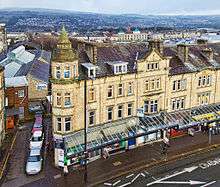
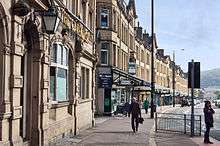


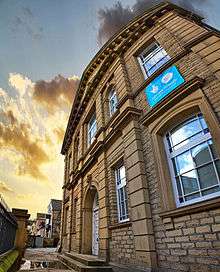
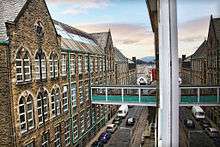

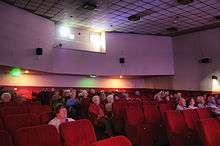
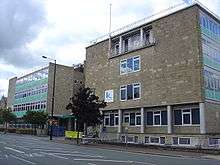

Keighley lies at the confluence of the rivers Worth and Aire in Airedale, in the South Pennines. Its northern boundary is with Bradley and its southern limit is the edge of Oxenhope. To the west, the town advances up the hill to the suburb of Black Hill and in the east it terminates at the residential neighbourhoods of Long Lee and Thwaites Brow. The outlying northeastern suburb of Riddlesden is sometimes incorrectly referred to as a separate village, but is part of the town.
Past Black Hill and via Braithwaite Edge Road lies Braithwaite village which leads to Laycock, which was mentioned in the Domesday Book. Laycock is a conservation area which overlooks the hamlet of Goose Eye.
The River Aire passes through north eastern Keighley, dividing the neighbourhood of Stockbridge and running roughly parallel to the Leeds and Liverpool Canal. The Worth links up with the Aire in Stockbridge and runs south-westerly, dividing eastern Keighley from central and western districts of the town. The Worth is lined with abandoned, semi-derelict industrial sites and tracts of waste ground dating from the period when Keighley thrived as a major textile centre.
Parts of Keighley are prone to flooding and the town was particularly badly hit in by floods 2000.[12][13] Since then, millions have been spent on strengthening flood defences.
Other outlying villages around the town are Oakworth, Cross Roads, Haworth, Stanbury and Oxenhope. The two main settlements to the north are Silsden and Steeton. Although these villages are often referred to as separate places they are part of the wider Keighley area. These areas add a total of 22,669 to the Keighley area, taking the population of the wider Keighley area up to 74,098 (2001 Census).
To the north east is Rombald's Moor which contains many signs of stone age and bronze age occupation including cup and ring marks,[14] and as it drops back down into Wharfedale and the town of Ilkley, approximately five miles away, becomes the more famous Ilkley Moor.
|
Demography
| Census population of the ancient parish/civil parish of Keighley | ||||||||||
|---|---|---|---|---|---|---|---|---|---|---|
| Year | 1801 | 1811 | 1821 | 1831 | 1841 | 1851 | 1861 | 1871 | 1881 | 1891 |
| Population | ||||||||||
| Source: Vision of Britain – Keighley AP/CP: Total Population.[15] | ||||||||||
| Census population of the municipal borough of Keighley | ||||||||||
|---|---|---|---|---|---|---|---|---|---|---|
| Year | 1901 | 1911 | 1921 | 1931 | 1939 † | 1951 | 1961 | 1971 | ||
| Population | ||||||||||
| Source: Vision of Britain – Keighley MB: Total Population.[16] | ||||||||||
† The 1939 population is estimated from the National Registration Act figures.[17] The 1941 census did not take place because of the Second World War.
Amenities
Much of the town centre has been pedestrianised. Keighley has three large supermarkets, Morrisons, Sainsbury's and Asda. The Airedale shopping centre, is a large indoor shopping precinct which houses most of the town's high street retail chains. There are several budget supermarkets situated in small retail parks around the town. Keighley benefits from an electrified railway service with connections to Leeds, Bradford, Shipley, Bingley, Skipton, Carlisle and Morecambe. The Keighley and Worth Valley railway is a heritage steam railway, which links the town with Haworth, Oakworth, Oxenhope and the Bronte Country. Keighley has one cinema, The Picture House on North Street which was restored from derelict condition in 1996 by Northern Morris Associated Cinemas.[18]
Religion
Keighley has a parish church Keighley Shared Church[19] and is home to many Christian denominations. It has churches and places of worship for Anglicans, Methodists, United Reformed, Mormons, Quakers, Salvation Army and Jehovah's Witnesses. Keighley has a significant Roman Catholic minority re-established following the repeal of the penal laws. The Catholic population was boosted in the mid-19th century with the arrival of Irish immigrants escaping the 1840s potato famine who came to work in the textile and weaving industries. Keighley has two Roman Catholic churches (St Anne's – 1840 and St Joseph's – 1934) and four Roman Catholic schools (St Anne's – 1857, St Joseph's – 1922, Our Lady of Victories – 1960 and Holy Family – 1964).
The first spiritualist church in Britain was founded at Keighley in 1853 by David Richmond,[20] who although not originally from the town, stayed for many years and helped to establish the movement throughout the country. Spiritualism was at its height during Victorian times and Keighley Spiritualist church remains open.
Muslims make up the second largest religious group in the town. According to the 2011 census there were more than 12,400 Muslims in Keighley in March of that year. Most had started coming to Britain in the 1960s from the Mirpur region of Azad Kashmir, in Pakistan, and the Sylhet region of Bangladesh. As of 2013 there were eight mosques in Keighley, including the purpose-built Markazi Jamia Masjid ('Central Community Mosque') in Emily Street, the Ghosia Mosque, in Cark Road, the Shahjalal Jamia Mosque, on Temple Row, and the Bait al-Aman Ahmadiyya Mosque, at the junction of Worth Way and Longcroft.
There is a Buddhist centre on Lawkholme Crescent, in the town centre. The Keighley Kadampa Buddhist Centre is used by lay and ordained Buddhist practitioners and also runs day and evening classes for newcomers to the faith.
Architecture
Like many other British towns and cities, Keighley was extensively remodelled in the 1960s and lost many historic buildings. However, the town managed to retain some of its heritage and has many Victorian buildings. The local millstone grit gives many of the buildings a distinctive look.
East Riddlesden Hall, Cliffe Castle Museum and Whinburn Mansion are fine, country houses. There are large town houses along Skipton Road which contrast with the cramped rows of terraces in the streets behind them.
The town's central library was the first Carnegie library in England opened in 1904 with a grant of £10,000 from Andrew Carnegie.[21] The library has undergone refurbishment which was completed in 2007. Many of the town's former mill buildings are still intact.
The town centre contains modern buildings such as Leeds City College and examples of Victorian commercial architecture, including the long terrace of Cavendish Street with its 220-yard (⅛ mile/a furlong) ornamental canopy. There is an award-winning bus station which opened in 2002 near the Airedale Shopping Centre.[22][23] There are several tower blocks in Parkwood Rise, Holycroft and Ingrow and a central multi-storey car park.
Amongst the modern houses in Laycock, 2 miles (3.2 km) outside Keighley town centre is a 17th-century three-storey manor house (which is said to be the former wing of a much bigger property), converted barns and 18th-century cottages.
Local attractions
On the outskirts of town is Cliffe Hall, also known as Cliffe Castle, now Keighley Museum.[24] Keighley is the location of the Keighley and Worth Valley Railway, a heritage railway that passes through Haworth (part of the Brontë Country, home of Anne, Charlotte and Emily Brontë) and terminates at Oxenhope. At Ingrow is the Museum of Rail Travel.
Top Withens and the Brontë Waterfall are within walking distance of Stanbury, a mile and a half from Haworth. East Riddlesden Hall is in Riddlesden. Keighley Police Museum is in the Keighley Civic Centre opposite the Town Square. It is the old police station and has many pieces of police memorabilia, including a Victorian horse-drawn Black Mariah.
Education
Local high schools are University Academy Keighley in Utley,[25] Oakbank School,[26] Parkside School in Cullingworth[27] and the Holy Family Catholic School.[28]
Keighley College, the local campus of Leeds City College, formerly known as Park Lane College, is situated near Keighley railway station on Dalton Lane. In 2010 the college opened this new £30 million campus, moving away from the former site on Cavendish Street which was in need of repair. The college includes an Industrial Centre of Excellence and a nationally acclaimed Star Centre facility,[29] designed to encourage more young people to study STEM subjects (science, technology, engineering, and mathematics). This features a mock mission control centre, a planetarium, a simulated rocky planet surface and many other space-related items.
Sport and entertainment
Keighley Cougars RLFC are a semi-professional rugby league team based at Royd Ings Avenue, they play in the Co-operative Championship continuing a recent history of promotion to and relegation from this league over the last 3 years. The ground's historical/traditional name is Lawkholme Lane but has more recently been named Cougar Park. Keighley RUFC are based at Rose Cottage, Utley and play in Yorkshire league one.
Keighley is home to Timothy Taylor's Brewery, the makers of CAMRA, Champion Beer of Britain award-winning ales Landlord and Boltmaker (previously known as 'Best Bitter'). They also brew Ram Tam, Golden Best, Dark Mild and a new French style blonde ale, Le Champion, which was first brewed for the Tour de France in 2014 and has been brewed for the Tour de Yorkshire in 2015 and 2016.[30] They also own many pubs in the area, including the Albert Hotel, Boltmakers Arms, Burlington Arms, Lord Rodney and Royal Oak in Keighley.
Keighley has a popular local music scene. There have been various venues where local bands play. Most notable was the now defunct CJ's bar (also known as Chrome, VW's, Cheese and Trumpet) that played host to many popular touring bands. Examples of local bands are The Undecided, We Are Atlas, Foxes Faux, the Sailmakers, Random Hand, the Get Guns, Eyesore Angels and Dead Message who recently parted ways after 9 years. The British rock bands Skeletal Family and Terrorvision were also originally formed in Keighley.
Keighley's Picture House, a cinema on North Street opened in 1913 making it one of the oldest in Britain. A brief closure in the mid-1990s prevented it from being listed as one of the oldest in continuous operation – a record that goes to the Curzon Cinema which opened in Clevedon, Somerset in 1911.
The Airedale Shopping Centre used to house the statue of the giant Rombald holding a boulder above his head. It was moved when a glass ceiling was added to the centre. According to local legend the giant Rombald threw a giant rock at his enemies (or in some versions of the tale his wife) killing them. The rock is the "calf" of "cow and calf" rock fame which can be seen today at the top of Rombald's Moor on Ilkley Moor.
On 6 July 2014, Stage 2 of the 2014 Tour de France from York to Sheffield, passed through the town. It was also the location of the stage's intermediate sprint after 42.6 miles (68.6 km). The 20 points for the Points jersey was claimed by Blel Kadri of AG2R La Mondiale.[31]
In film
Keighley was the setting for the film Blow Dry starring Josh Hartnett, Alan Rickman and Bill Nighy. Blow Dry opens with the announcement that the small town of Keighley will host the year 2000 British Hair Championships. Keighley's mayor (Warren Clarke) is thrilled about the news, but when he announces it to the town's press, they all yawn disapprovingly. The film although set in Keighley was shot in several locations.[32]
The 2004 documentary Edge of the City, about the City of Bradford Social Services, and the people and problems they deal with, was partly filmed in Keighley, and concerned sexual abuse of underage white girls by some Asian men.[33]
Most of the 2004 film Yasmin was shot in Keighley. Written by Simon Beaufoy and mostly filmed in Lawkholme, it tells the story of a British Muslim woman who has her life disrupted by the impact of the September 11 attacks on America. Mr Beaufoy said the film was originally set in Oldham, but "worked its way across the Pennines".
The Keighley and Worth Valley Railway (KWVR), running steam trains from Keighley to Haworth and Oxenhope, has been used in several films, including The Railway Children, Yanks, the film of the Pink Floyd musical The Wall and an episode of the long-running situation comedy, The Last of the Summer Wine.
A great part of the 2004 BBC television drama North and South was shot on Keighley, with Dalton Mill being one of the serial's main locations.[34]
In 1978 the former railway station which is now on the site of the supermarket Sainsbury's, was used as a setting in the Second World War period drama film "Yanks" where many of the local residents were used as part of the cast.
A Touch of Frost starring David Jason was also filmed at the railway line close to Ingrow West.
The 1950s set British feature film Between Two Women (2000) was filmed extensively in and around Keighley and its mills, in particular around the railway and close to the main town railway station. The same director's next film The Jealous God (2005) also featured Keighley railway station and nearby streets.
Christopher Ingham
Utley Cemetery contains the grave of Christopher Ingham, a veteran of the conflict against Napoleon. He was a member of the Duke of Wellington's elite 95th Rifle Regiment and fought in ten battles against the French in Spain, France and Belgium including the Spanish Peninsula War and the Battle of Waterloo, for which he was awarded several medals, including the Peninsula Medal. He died in 1866. Some local historians believe Mr Ingham's heroism may have inspired the author Bernard Cornwell's saga about Major Richard Sharpe.[35] The TV series episode Sharpe's Justice, which focuses on the roots of the title character, is set in and around Keighley.
Hindenburg parcel
on 22 May 1936, the Zeppelin Hindenburg crossed Yorkshire in a diversion of her normal route between the United States and Germany.[36] As the airship was passing over the town, a parcel was dropped and landed in the High Street which was picked up by two boys. The parcel contained a bunch of carnations, a small silver and jet crucifix, some postage stamps, a picture postcard and some Hindenburg notepaper.[37]
The note was written by John P Schulte who called himself the first flying priest. The note requested that the carnations and crucifix be placed on the grave of his brother, Lieutenant Franz Schulte, who died as a Prisoner of War in the Keighley area and who was, at that time, buried at Morton Cemetery 2 miles (3.2 km) east of Keighley (though the letter states he is buried at Skipton, this was incorrect).[38]
To the finder of this letter. Please deposit these flowers and the cross on the grave of my dear brother, Lieutenant Franz Sculte, I. Garde Regt zu Fuss. Prisoner of War in Skipton Cemetery in Keighley near Leeds. Many thanks for your kindness, John P Schulte, the first flying priest. N.B. Please accept the stamps and picture as a small souvenir from me. God bless you!
Ian Dewhirst, [39]
The carnations were placed on the grave and the two boys kept the postage stamps and the postcard. The crucifix was placed in St Anne's Church to avoid it being stolen.[39]
Notable people with Keighley links
The following people were born in Keighley, have lived there in the past or are currently resident in the town.
- Simon Beaufoy, (1967–), An Oscar, Bafta and Golden Globe award-winning British screenwriter who was born in Keighley
- Gordon Bottomley, (1874–1948), poet was born and educated in Keighley
- Asa Briggs, (1921–2016), renowned historian and academic, born in Keighley
- Brontë Sisters, lived in the village of Haworth, which is two miles (3 km) south of Keighley
- Alastair Campbell, (1957–), former Labour party spin doctor who was born in Keighley[40]
- John Tiplady Carrodus, (1836–1895), violinist
- Kiki Dee, (1947–), successful singer-songwriter, originally from Bradford, whose career spanned 40 years
- Ian Dewhirst, Former librarian of Keighley MBE local historian
- Ellis Hall, Bowman at the Battle of Flodden[41]
- Peter Hartley, (1960–), former county cricketer for Warwickshire and Hampshire
- Denis Healey, (1917–2015), a prominent Labour party politician who has previously served as Chancellor of the Exchequer and Secretary of State for Defence[42]
- Mike Hellawell, (1938–), professional footballer who made two appearances for England and also played for Birmingham City, Queens Park Rangers and Sunderland
- Trevor Hockey, (1943–1987), Welsh international footballer, who also played with Bradford City and Birmingham City
- Sir Isaac Holden, 1st Baronet, (1807–1897), inventor and manufacturer, known for lucifer matches, and served as Liberal MP for Keighley 1888–1895
- Lesley Horton, Crime novelist and author of the detective inspector John Handford series lives in Keighley
- Paul Hudson, (1971–), local television weather forecaster was born in the town
- Saima Hussain, (1979–), first Asian female rugby player to represent Great Britain[43]
- Keith Jessop, (1933–2010), salvage diver and successful marine treasure hunter
- Peter Judson, (1970–), a former boxer who challenged for the British featherweight title in the 1990s
- Henry de Keighley, (−1313), granted the first charter to hold a market in Keighley on 17 October 1305 by King Edward I[5]
- John Kilcoyne, a star of the television programme Brainiac: Science Abuse was born and raised in Keighley
- Dougie Lampkin, (1976–), born Silsden is an internationally renowned motorcycle trials rider
- Tommy Lee, (1986–), footballer who is a goalkeeper for Chesterfield
- Leigh Marklew, (1968–), of Bradford rock band Terrorvision, is a native of Keighley
- Peter Mayhew, (1944–), British actor who played Chewbacca in the Star Wars films, lived in Keighley between 1987 and 2000[44]
- Chris Melling (1979–), professional pool player and former world number one
- Ian Mosey, professional golfer. Winner of two European Tour events.
- Reynold Alleyne Nicholson, (1868–1945) was an eminent English orientalist, scholar of both Islamic literature and Islamic mysticism, and widely regarded as one of the greatest Rumi scholars and translators in the English language.
- George Nicholson, (1760–1825), printer born in Keighley[45]
- Eric Pickles, (1952–), former Secretary of State for Communities and Local Government and a former Chairman of the Conservative Party was born in the town
- Michael Sams, (1941–), murderer[46]
- Geoff Smith, (1928–2013), former Bradford City goalkeeper, lived in Keighley
- Michelle Smith, (1983–), Rifle Shooter who won Silver at the 2010 Commonwealth Games in Delhi, IND.
- Philip Snowden, (1864–1937), the first Labour Chancellor of the Exchequer was born in Cowling. He was also the editor of the Keighley Labour Journal and in 1906 became the MP for Blackburn.
- Mollie Sugden, (1922–2009), television comedy actress
- Sir John Taylor, Baron Ingrow, Lord Ingrow, (1917–2002), a soldier and politician. From 1985 to 1992 he was Lord Lieutenant of West Yorkshire
- Timothy Taylor, (1826–1898), local brewer who opened the Timothy Taylor's Brewery in 1858
- Percy Vear, (1911–1983), a British professional boxer during the 1920s and 1930s
- Ricky Wilson, (1978), musician and part of Leeds five-piece Kaiser Chiefs, is a native of Keighley
- Margaret Wintringham, (1879–1955), the second woman to take a seat in the House of Commons[47]
- Frank Whitcombe, (1913–1958), Bradford Northern & Great Britain international rugby league player
- Frank Whitcombe Jr, (1936–2010), Bradford RFC Yorkshire RUFC & North Eastern Counties RUFC
- Martin Whitcombe, (1961–), Leicester Tigers, Yorkshire RUFC & England 'B' International Rugby Union player.
- Jake Wright, (1986–), professional footballer who plays for Oxford United
Opinions about Keighley
The town was mentioned in the John Cooper Clarke poem, "Burnley": "I'll tell you now and I'll tell you briefly, I don't ever want to go to Keighley."
In 2003, The Idler magazine set up an online poll to decide which were the 50 worst places to live in Britain. The results were published in the book Crap Towns: The 50 Worst Places to Live in the UK. Keighley came in at number 40. Keighley's local newspaper, the Keighley News, reported the reaction of Councillor Andrew Mallinson, chairman of Keighley Town Centre Management Group: "On the positive side, it's nice to know that out of all the towns in the country, Keighley has got a mention! But on a serious note, as a group, we take any complaints or concerns seriously and are always striving to improve the town centre's image."
Politics
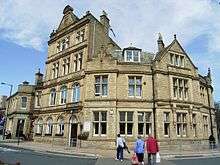
Keighley is represented in the House of Commons by Conservative Member of Parliament (MP) Kris Hopkins, who won the seat at the 2015 general election – securing a second term. Hopkins increased the Conservatives vote share in the area from 41.9%[48] in 2010 to 44.3%[49] in 2015. The Conservatives won the seat in 2010, taking over from Ann Cryer who had been in office since 1997.
Keighley was contested by the British National Party (BNP) in the May 2005 general election when the party's leader Nick Griffin stood for Parliament. He was defeated by Ann Cryer, one of a small number of Labour MPs with an increased majority. In March 2006, the town's mayoress, Rose Thompson, announced she had joined the BNP.[50]
In June 2006, the leader of Bradford District Council, Conservative Councillor Kris Hopkins, was quoted in the Craven Herald & Pioneer as suggesting it might be a good idea for Keighley to become an independent authority once again.[51]
Keighley has had a town council since 2002.[9] In 2015, a police probe launched the previous year had developed into a fraud investigation following an external audit report – highlighting a number of financial weaknesses and poor governance in the council's 2012/12 accounts.[52]
A turf war between local drug gangs resulted in the murder of four Asian men in a 5 1⁄2-month period, from September 2001 to February 2002. Those killed were Yasser Hussain Nazir, Yasser Khan, Zaber Hussain and Qadir Ahmed. Qadir, was stabbed and beaten to death near Victoria Park after being ambushed and chased by rival gang members. The killings sparked a police investigation leading to the arrest of a number of men who were given long prison sentences.[53]
Town twinning
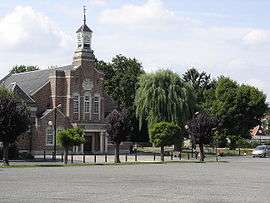
Keighley has the unique record of having the first recorded town twinning agreement in the world entering an agreement with Poix-du-Nord, France in 1920.[54][55] This actually followed an even earlier sister city arrangement with two communes on the outskirts of Paris, France – Suresnes and Puteaux – starting in 1905.[54][56]
 Myrtle Beach, South Carolina, USA
Myrtle Beach, South Carolina, USA Poix-du-Nord, Nord, Hauts-de-France, France
Poix-du-Nord, Nord, Hauts-de-France, France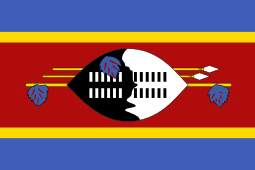 Manzini, Swaziland
Manzini, Swaziland
Local books of interest
- KEIGHLEY PAST and PRESENT; AN HISTORICAL, TOPOGRAPHICAL and STATISTICAL SKETCH of THE TOWN, PARISH and ENVIRONS of KEIGHLEY
- The life of Charlotte Brontë by Elizabeth Cleghorn Gaskell
- William Grimshaw, incumbent of Haworth, 1742–63 By Robert Spence Hardy
- History of Bradford, and its parish By John James
- The History and Topography of Bradford, (in the county of York,) by John James
- Babbage Report, Haworth, 1850
- The master spinner; a life of Sir Swire Smith
- Ancient Bingley: or, Bingley, its history and scenery (1897). Author: Turner, J. Horsfall
- Robert Collyer Methodist preacher and blacksmith
- Haworth – past and present: a history of Haworth, Stanbury & Oxenhope
- A Century of Yorkshire Dialect: Selections from the "Transactions of the Yorkshire Dialect Society"
- A History of Keighley by Ian Dewhirst
- Gleanings from Victorian Yorkshire by Ian Dewhirst
- Gleanings from Edwardian Yorkshire by Ian Dewhirst
- In the Reign of the Peacemaker by Ian Dewhirst
- Keighley and District in Edwardian Photographs by Ian Dewhirst
- Keighley at War by Ian Dewhirst
- Keighley in Old Picture Postcards by Ian Dewhirst
- Keighley in the 1930s and '40s by Ian Dewhirst
- More Old Keighley in Photographs by Ian Dewhirst
- The Story of a Nobody: A Working Class Life, 1880–1939 by Ian Dewhirst
- Old Keighley in Photographs by Ian Dewhirst
- Scar Top and other poems by Ian Dewhirst
- The Handloom Weaver and other poems by Ian Dewhirst
- Yorkshire Through the Years by Ian Dewhirst
- You Don't Remember Bananas by Ian Dewhirst
- Victorian Keighley Characters by Ian Dewhirst
- Keighley's Darkest Secrets – Malcom Hanson
- The History of Lees Methodist Church by Maurice Baren
- Keighley Murders and Other Tales by Lewis Parker
- Tales of Old Airedale: A Miscellany by Lisa Firth
References
- ↑ "About Keighley". Keighley Online. 6 January 2015. Retrieved 30 November 2016.
- ↑ "Keighley CP (Parish)". Neighbourhood Statistics. Office for National Statistics. Retrieved 3 February 2008.
- ↑ "Keighley Parish". Neighbourhood Statistics. Office for National Statistics. Retrieved 12 April 2016.
- ↑ "Keighley – Name Meaning". ancestry.com. Retrieved 24 January 2009.
- 1 2 "Latin Expert Sought to Decipher Charter". Keighley News. 15 January 2009. Retrieved 24 January 2009.
- ↑ "1379 Yorkshire Poll Tax Subsidy Rolls". Retrieved 24 January 2009.
- ↑ "Keighley Town Centre Conservation Area Assessment" (PDF). Transportation, Planning and Design Department, the City of Bradford Metropolitan District Council. Retrieved 18 October 2012.
- ↑ "Keighley grappling to find Voice for the future". Keighley News. 9 April 2001.
- 1 2 "Town council makes history". Telegraph & Argus. 24 May 2002.
- ↑ "Keighley and District Family History Society".
- ↑ "KIVCA".
- ↑ "Flood: Hundreds Homeless as Floods Hit". Telegraph & Argus. 3 November 2000. Retrieved 24 January 2009.
- ↑ "Floods Could Cost Millions". Keighley News. 1 November 2000. Retrieved 24 January 2009.
- ↑ "Rombald's Moor Stone Circles". Retrieved 24 January 2009.
- ↑ "Keighley AP/CP: Total Population]". Vision of Britain. Retrieved 1 March 2008.
- ↑ "Keighley MB: Total Population". Vision of Britain. Retrieved 1 March 2008.
- ↑ "National Registration Act, 1939". Rootsweb.com. Retrieved 8 June 2007.
- ↑ "Northern Morris Associated Cinemas".
- ↑ "Keighley Shared Church".
- ↑ "History of Modern Spiritualism". Retrieved 24 January 2009.
- ↑ "Keighley Public Library". Retrieved 24 January 2009.
- ↑ "Shopping Centre Award for Keighley Bus Station". Retrieved 24 January 2009.
- ↑ "New bus station is just the ticket". Keighley News. 8 February 2002. Retrieved 24 January 2009.
- ↑ "keighleyonline". Retrieved 3 February 2008.
- ↑ "University Academy Keighley". Retrieved 3 August 2011.
- ↑ "Oakbank School". Retrieved 3 February 2008.
- ↑ "Parkside School". Retrieved 3 February 2008.
- ↑ "The Holy Family Catholic School". Retrieved 3 February 2008.
- ↑ "STAR centre may be leading light in next space race". Keighley News. 2 March 2008. Retrieved 24 January 2009.
- ↑ "Our Range of Beer". Timothy Taylor. Retrieved 1 November 2016.
- ↑ "Tour de France Stage 1". Retrieved 15 July 2014.
- ↑ "Blow Dry (2001) – Filming locations".
- ↑ "Edge of the City". Channel 4. Retrieved 24 January 2009.
- ↑ "North and South – Soundtrack and Location information". BBC Drama. Retrieved 24 January 2009.
- ↑ "Woman pays tribute to Sharpe hero". Telegraph & Argus. 7 November 2003.
- ↑ "The Day The Hindenburg Visited Yorkshire". Yorkshire Air Museum. 17 March 2016. Retrieved 1 November 2016.
- ↑ "Keighley schoolchildren to make film about Hindenburg visit before Second World War". Keighley News. 12 February 2015. Retrieved 1 November 2016.
- ↑ "Riddlesden man made famous by crucifix-find dies aged 89". Telegraph & Argus. 14 July 2014. Retrieved 1 November 2016.
- 1 2 Dewhirst, Ian (1974). "10". A History of Keighley. Keighley: Tempus. p. 135. OCLC 41722645.
- ↑ "Campbell cashes in his chips". Scotland on Sunday. 31 August 2003.
- ↑ "Two Torches at Keighley". Retrieved 4 December 2015.
- ↑ "Denis Healey biography". spartacus.schoolnet. Retrieved 3 February 2008.
- ↑ "Rugby's Hussain fights tradition". Kick it Out. 17 April 2002. Retrieved 24 January 2009.
- ↑ "Star Wars giant returns". Telegraph & Argus. 2 May 2003. Retrieved 24 January 2009.
- ↑ Oxford Online Dictionary of National Biography – George Nicholson
- ↑ Yorkshire and Lincolnshire: The Price of Justice? BBC News
- ↑ Oxford Online Dictionary of National Biography: Margaret Wintringham
- ↑ "BBC Election Results". BBC. Retrieved 20 June 2015.
- ↑ "BBC Election Results". BBC.
- ↑ "BNP Mayoress stripped of position". BBC News. 13 March 2006. Retrieved 24 January 2009.
- ↑ "South Craven 'could split from Bradford'". Craven Herald & Pioneer. 14 July 2006. Retrieved 24 January 2009.
- ↑ Mirhan, Rahman. "Fraud investigation into Keighley Town Council". Keighley News.
- ↑ "Tit-for-tat gang war plunged into killings". Telegraph & Argus. Retrieved 21 March 2008.
- 1 2 "France Magazine – Twin Towns". www.francemag.com. Retrieved 6 November 2009.
- ↑ Handley, Susan (2006). Take your partners: The local authority handbook on international partnerships. London: Local Government International Bureau. p. 4. Retrieved 20 September 2009.
- ↑ Frank Crane (2008). War and World Government. BiblioBazaar, LLC. p. 200. ISBN 978-0-559-44381-7. Retrieved 20 September 2009.
External links
| Wikimedia Commons has media related to Keighley. |
- Keighley Town Council
- Keighley Shared Church
- Keighley at DMOZ
- Keighley Kicks – Covering local football in Keighley
- Keighley Online – News, business and Keighley community site

